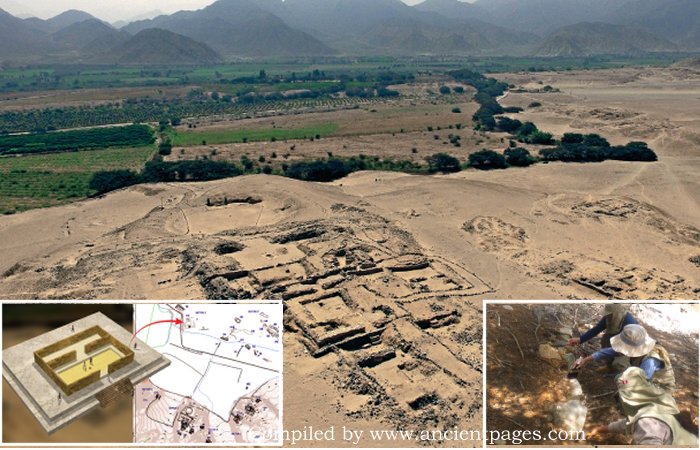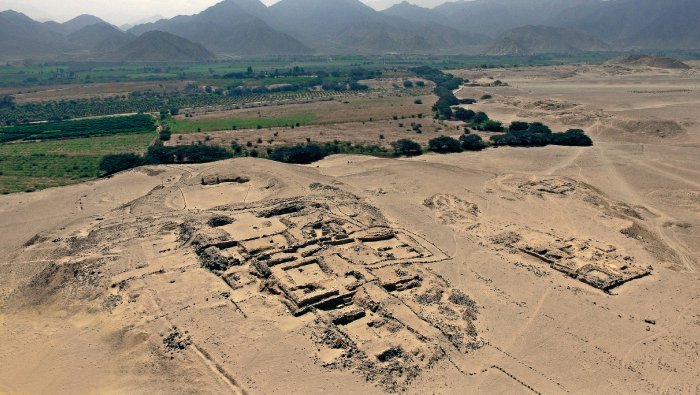Conny Waters – AncientPages.com – Recent excavations at the Chupacigarro archaeological site in the Supe Valley near Caral, a pre-Hispanic city in Peru, have unveiled a previously unknown ancient pyramid. Caral, recognized as a UNESCO World Heritage Site, is notable for being home to the oldest civilization in the Americas, the Caral or Norte Chico Civilization, which flourished from 3000 to 1800 B.C.
Credit: Caral Archaeological Zone
Covering over 60 hectares (150 acres) and housing around 3,000 inhabitants, Caral showcases remarkable achievements by its skilled builders and engineers. Despite its historical significance, few know that this Sacred City was established approximately 4,400 years before the Inca Empire.
Caral is celebrated for its sustainable urban planning and features an intricate complex of temples, residential areas, and an impressive theater, all harmoniously integrated with nature. The pyramids of Caral date back to as early as 2600 B.C., with construction continuing until about 2000 B.C. Their age rivals that of Egypt’s Pyramids of Giza and Cheops, built between 2600 and 2480 B.C.
Credit: Caral Archaeological Zone
Peruvian authorities reported the latest discovery following work led by Dr. Ruth Shady and a multidisciplinary team from the Caral Archaeological Zone. Found in Sector F of Chupacigarro under dense vegetation, like dry huapango trees, the structure revealed stone walls forming at least three superimposed platforms, the Peruvian Ministry of Culture informed in a press release statement.
The stone walls are distinguished by large, vertically placed stones called “huancas.” These stones mark the corners of the quadrangular building and the central staircase that provides access to the top. The central staircase is an architectural feature typical of the Caral civilization.
The Peruvian Ministry of Culture explained that research in this new building will enable the team from the Caral Archaeological Zone to learn about the complete urban layout of the Chupacigarro urban center. It will also enhance this settlement, making it accessible for visits alongside Caral.
Credit: Caral Archaeological Zone
The Chupacigarro settlement is a crucial component of the extensive settlement network in the Supe Valley, strategically positioned along a vital natural route linking the valley to the Huaura coast. Covering 38.59 hectares, this remarkable site features 12 public or ceremonial structures perched on small hilltops encircling a central area in the ravine.
Credit: Caral Archaeological Zone
This location served as an essential natural pathway to the coast and underscored its significance within this interconnected system. Understanding its strategic importance and unique layout makes it clear why Chupacigarro is indispensable to comprehending regional dynamics and historical development.
Experts have observed that these buildings differ in size, orientation, and characteristics, likely due to their varied functions. The most prominent feature is the Main Building, which has a sunken circular plaza, a distinctive element of Caral architecture. The variety of architectural styles and construction phases at Chupacigarro indicates multiple uses and suggests it may have extended the Sacred City of Caral-Supe. Its strategic position enabled interactions with communities in the lower Supe Valley and Huaura coast, providing access to marine resources. Residents also had immediate access to riverside forests, springs, stone quarries, and agricultural fields.
See also: More Archaeology News
Interestingly, Chupacigarro was not visible from within the valley itself; this suggests it might have been an extension of Caral-Supe for private or religious purposes. A notable feature is a geoglyph depicting a human head in profile crafted in Sechín style using angular rocks; it measures 62.1 by 30.3 meters and can only be seen from specific angles within the settlement. This design shows a face looking eastward with distinct features such as a closed eye and open mouth—possibly representing hair blown by wind or blood flowing from its head.
Some archaeologists propose that this geoglyph had ceremonial significance related to the religious or cosmological beliefs of the Caral civilization. Its deliberate placement within Chupacigarro underscores its role within this ancient region’s broader cultural and ritual contexts.
Written by Conny Waters – AncientPages.com Staff Writer













